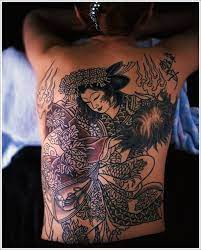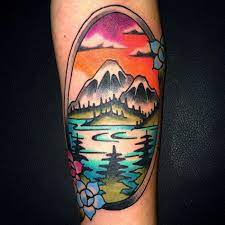
Geisha Tattoos
Geisha tattoos are exquisite works of art that embody femininity. Typically, they consist of a decorative fan, flowers, and the symbolic Koi fish representing strength and perseverance. Geisha often wear kitsune masks, which symbolize godly foxes that can both be good and bad – describing their dual nature as women – pure yet with dark sides.
Geisha Among Lotus Full Back Tattoo
Geisha girls symbolize beauty, culture, and dedication to lifelong work. Admired throughout Japan for their graceful appearance, refined tastes, and unique styles, Geisha girls continue to inspire admiration by all who come in contact with them.
Flowers and plants are popular elements in Japanese tattoos. Cherry blossoms symbolize springtime and transience while simultaneously symbolizing beauty and its transient nature. Peaches symbolize longevity while protecting from evil.
Tattoos were once widely considered unacceptable in Japanese culture; however, over time, they’ve become more accepted across all areas, from hot springs and bathhouses to public beaches. Even so, tattoos remain taboo at work; showing them may disqualify job-seekers from finding employment at specific companies. But for those able to show them without being disapproved of by employers, Japanese Tattoos can provide a beautiful way of expressing cultural identity and artistic flair.
Koi Fish Upstream Full Back Tattoo
Koi fish tattoos are increasingly popular as they symbolize perseverance and courage. Koi are commonly associated with Samurai warriors for their courageous nature and ability to swim upstream against current currents, an admirable feat.
Koi fish carry different symbolic meanings depending on their color and pairing symbolism. For instance, black koi may represent your successful pursuit of complex challenges while signifying partner loyalty.
A koi fish and cherry blossom tattoo is an excellent way to show your heritage, symbolizing strength and courage while reminding us how short life can be. This striking design makes for an elegant piece that would look fantastic on any leg, particularly suitable for placing on the calf due to its thick skin.
Goldfish Full Back Tattoo
Goldfish are domesticated forms of Asian carp that have been selectively bred over centuries for specific physical traits, making them a symbolic representation of wealth and abundance – often used to celebrate Chinese New Year.
This stunning Japanese sleeve tattoo depicts goldfish with Lotus flowers as traditional signs of luck and abundance. Koi fish have long been seen as symbols of perseverance and strength, particularly among women looking for encouragement to overcome challenges and succeed in life. This contemporary take on koi is beautiful, with its black hue adding even further charm.
Japan may not be as accepting of Tattoos as many other Asian countries; however, recent changes show some hopeful signs. Still, it’s best to err on caution and check with hotels or intended venues before getting one. Wear loose-fitting clothing that covers your tattoo when possible to ensure maximum visibility.
Great Wave Off Kanagawa Full Back Tattoo
Katsushika Hokusai’s iconic artwork has long been an influence for tattoo enthusiasts. This piece exemplifies waves’ strength and beauty while appearing encircled – seemingly never breaking.
Geisha tattoos represent cultured, beautiful, and feminine craftsmanship highly revered in Japan; they’re also seen as a sign of dedication and perseverance.
Samurai Tattoos are a symbolic representation of loyalty and honor. Usually adorned with cherry blossoms to represent fragility and remembrance, samurai tattoos offer a powerful statement about both.
Tattoos from Japan often draw their inspiration from nature due to Japanese culture’s reverence for nature and Ukiyo-e prints, creating unique body art pieces inspired by nature. While foreigners and tourists may enjoy access to hot springs, pools, or beaches without restrictions for having tattoos in public spaces, residents could still face being denied these privileges.

